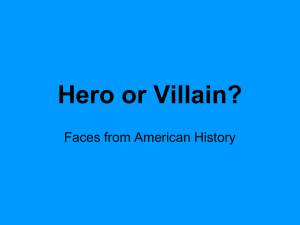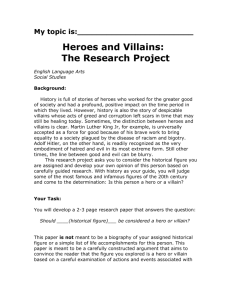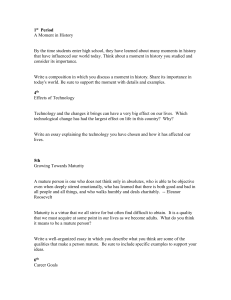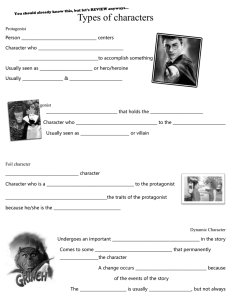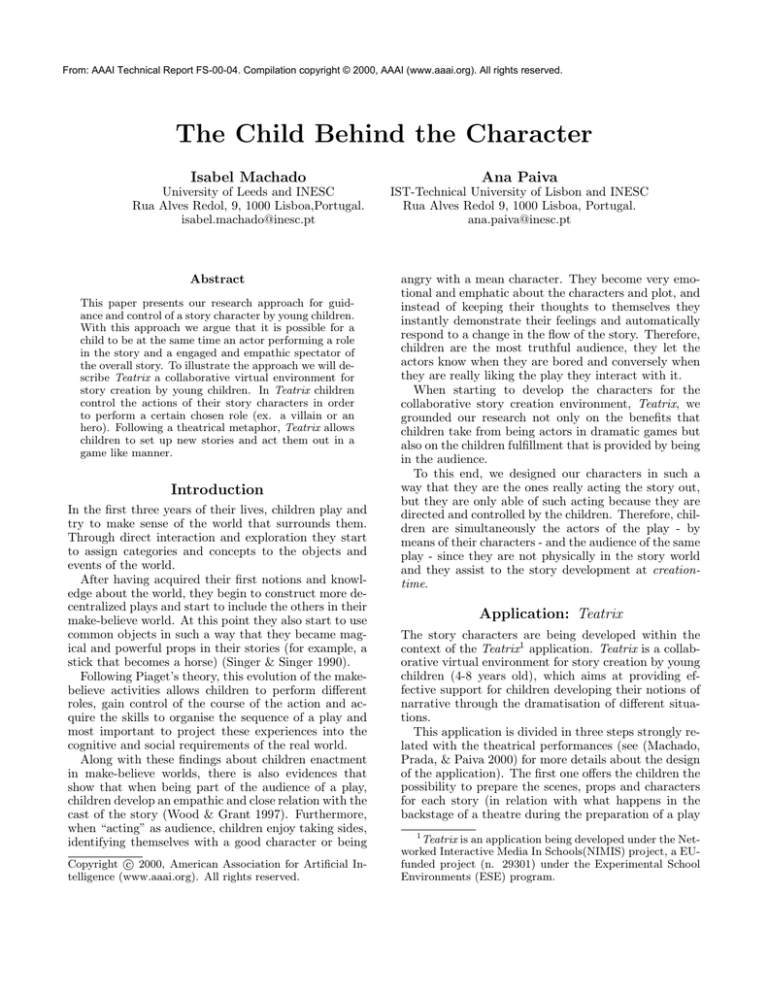
From: AAAI Technical Report FS-00-04. Compilation copyright © 2000, AAAI (www.aaai.org). All rights reserved.
The Child Behind the Character
Isabel Machado
Ana Paiva
University of Leeds and INESC
Rua Alves Redol, 9, 1000 Lisboa,Portugal.
isabel.machado@inesc.pt
IST-Technical University of Lisbon and INESC
Rua Alves Redol 9, 1000 Lisboa, Portugal.
ana.paiva@inesc.pt
Abstract
This paper presents our research approach for guidance and control of a story character by young children.
With this approach we argue that it is possible for a
child to be at the same time an actor performing a role
in the story and a engaged and empathic spectator of
the overall story. To illustrate the approach we will describe Teatrix a collaborative virtual environment for
story creation by young children. In Teatrix children
control the actions of their story characters in order
to perform a certain chosen role (ex. a villain or an
hero). Following a theatrical metaphor, Teatrix allows
children to set up new stories and act them out in a
game like manner.
Introduction
In the first three years of their lives, children play and
try to make sense of the world that surrounds them.
Through direct interaction and exploration they start
to assign categories and concepts to the objects and
events of the world.
After having acquired their first notions and knowledge about the world, they begin to construct more decentralized plays and start to include the others in their
make-believe world. At this point they also start to use
common objects in such a way that they became magical and powerful props in their stories (for example, a
stick that becomes a horse) (Singer & Singer 1990).
Following Piaget’s theory, this evolution of the makebelieve activities allows children to perform different
roles, gain control of the course of the action and acquire the skills to organise the sequence of a play and
most important to project these experiences into the
cognitive and social requirements of the real world.
Along with these findings about children enactment
in make-believe worlds, there is also evidences that
show that when being part of the audience of a play,
children develop an empathic and close relation with the
cast of the story (Wood & Grant 1997). Furthermore,
when “acting” as audience, children enjoy taking sides,
identifying themselves with a good character or being
c 2000, American Association for Artificial InCopyright telligence (www.aaai.org). All rights reserved.
angry with a mean character. They become very emotional and emphatic about the characters and plot, and
instead of keeping their thoughts to themselves they
instantly demonstrate their feelings and automatically
respond to a change in the flow of the story. Therefore,
children are the most truthful audience, they let the
actors know when they are bored and conversely when
they are really liking the play they interact with it.
When starting to develop the characters for the
collaborative story creation environment, Teatrix, we
grounded our research not only on the benefits that
children take from being actors in dramatic games but
also on the children fulfillment that is provided by being
in the audience.
To this end, we designed our characters in such a
way that they are the ones really acting the story out,
but they are only able of such acting because they are
directed and controlled by the children. Therefore, children are simultaneously the actors of the play - by
means of their characters - and the audience of the same
play - since they are not physically in the story world
and they assist to the story development at creationtime.
Application: Teatrix
The story characters are being developed within the
context of the Teatrix1 application. Teatrix is a collaborative virtual environment for story creation by young
children (4-8 years old), which aims at providing effective support for children developing their notions of
narrative through the dramatisation of different situations.
This application is divided in three steps strongly related with the theatrical performances (see (Machado,
Prada, & Paiva 2000) for more details about the design
of the application). The first one offers the children the
possibility to prepare the scenes, props and characters
for each story (in relation with what happens in the
backstage of a theatre during the preparation of a play
1
Teatrix is an application being developed under the Networked Interactive Media In Schools(NIMIS) project, a EUfunded project (n. 29301) under the Experimental School
Environments (ESE) program.
- Figure 1).
Figure 2: Teatrix: On Stage Option
Figure 1: Teatrix: Backstage Option
The second step provides the children with the possibility to initiate one story and to start the acting (on
stage performance).
This option is realized in a collaborative 3D world
(see Figure 2). In this phase, virtual reality technology
plays an important role since it provides the children
with the means to explore the scenes during the story
creation (Roussos et al. 1996). The story creation only
evolves if the children work together to achieve a common goal: their story. From the story creation process
a ”film”-like object is created. This ”film”-like object
offers the children with a product, which they can analyze and even to reconstruct in future performances.
Furthermore, the children get much more from an
interaction or experience if in the end they will create
a meaningful artifact, that they can exhibit as a proof
of their individual or collaborative work (Papert 1991).
The third option is based on the artifact produced
from the story creation process. In this phase, children can be the audience of their own performances
and watch their previous performances (as being the
audience or the public in the Theatre). In this option
the children have also the possibility to write about the
stories previously performed. With this part we want to
provide the children with the opportunity of watching
and discussing what they’ve produced. By supporting
the discussion of the story we aim to promote a bet-
ter understanding of the characters interactions, and
maybe to encourage the reflection of the children about
the emotional and intellectual parts of the story (Dautenhahn 1998).
The children construct their stories from a set of predefined scenarios, props and characters and the acting
occurs in a 3D story world. To create a collaborative
story, each child, participating in the story creation,
chooses a character to direct and during the acting she
directs her character by simply selecting actions to be
performed in the story world (in figure 2 the acting
activity is shown).
To achieve the main goal of Teatrix, a narrative guidance system is being developed, which aims at mediating the story creation process and providing the children with an effective support for improving their notion of narrative.
Characters in Teatrix
As has been stated before the characters are the ones
that are going to act in the story and to do this they
must display a believable behaviour to engage the children in an fulfilling experience, which would help them
to understand the real world by means of the stories
(Dautenhahn 1998). To achieve these requirements, in
the design of our characters we followed the methodology presented by Martinho and Paiva in (Martinho &
Paiva 1999). Such methodology encompasses 7 steps:
1. Definition of the actors available;
2. Definition of the characters’ roles, i.e, the roles that
the characters will perform in the stories;
3. Assignment of a personality type to each role type;
4. Definition of the behaviour features for all the combinations actor x role;
5. Definition of the agent’s view of the world, i.e., specification of interest filters based on the roles;
6. Definition of the each role’s emotional profile;
7. Integration of the emotional behaviour with the character’s reasoning process.
Story characters are the conjunction of two different
concepts: actor and role concepts. An actor is the physical representation or appearance of a character (examples: a witch, a boy, a girl, etc.). A role is the definition
of a set behaviours that are known to both the characters and the audience (Hayes-Roth 1997). In Teatrix,
the roles definition was based on the seminal work done
by Propp (Propp 1968) on one hundred Russian folktales (see (Machado & Paiva 1999) for more details on
the characters definition). The roles are:
Villain the role of the villain is to disturb the peace
of the happy family, to cause misfortune, damage or
harm. The villain may be a dragon, a devil, a witch,
a stepmother, or even a little boy or a girl.
Hero/Heroine Introduced by his/her name indicating his/her status. Propp presents two types of
heroes: the seekers, which go in search of a loved
element; and the victimized heroes, whom are themselves the victim of the villainy.
Helper It has special functions in the story and it can
be represented in many forms. For example: (1) an
animal (a horse; a bird, etc); or (2) objects out of
which the magical helpers appear (a ring; a lantern;
etc); (3) objects with magical properties (a ring; a
sword; etc) or (4) qualities or capacities given directly
to the hero/heroine.
Beloved one and Family Usually described in the
initial situation, and is often subject to harm by the
villain.
Donor or the provider . It is from this personae
that the hero obtains some agent (sometimes magical) which allows the hero to eliminate the misfortune.
These roles define and establish the functional behaviour of an agent, by means of the specification of
the actions and goals for that agent (examples: villain,
hero, donor, etc.). With this well defined set of roles
and actors we aimed at providing the children with a
set of varied characters who are interesting, identifiable
and fun and at the same time that have the means to
develop and grow throughout the story creation process
(Wood & Grant 1997).
To better understand how a story character is constructed let’s assume the example of a child choosing
the actor girl to perform the role villain and follow step
by step the methodology:
1. Actor = girl.
2. Role = villain. Goals of this role: (1) to do some
actions in order to injury the other characters (in
particular the character performing the role of the
hero); (2) to enter in direct fight with the hero; (3)
and, to pursuit and defeat the hero.
3. Personality of the role villain: she has a cold personality and her way of acting is very conventional
and one can always expect the same kind of reactions
for some key situations(for example: when trying to
deceive the victim, to pursuit the hero, etc.). Although, the villain character is a cold character she
displays an active and talkative behaviour in order to
deceive and mislead her victims. Also, when the villain character starts a conversation with her victim,
she makes uses of her cynical and unreliable personality and tries to delude the victim with lies.
4. Behaviour features: Gloating - when she deceives the
hero; Disappointed - when she does not deceive the
hero; Satisfied - when she succeeds to harm the hero.
Of course this behaviour features are constrained by
the type of actor performing the role and they differ
in accordance with it.
5. This character has interest filters for the characters
performing the roles hero and donor. Any character
performing the role donor is also interesting for the
villain, since it has the power of helping the hero to
defeat the villain by giving him some magical object.
6. At this point, we should define the thresholds of the
emotions for this particular role. In particular, the
role villain has low thresholds for the following emotions: gloating, satisfaction and disappointment.
This method is used to create specific characters for
each story set up. Once the set up phase is done, each
child has her character to direct and can start playing
her story (or a collaborative story if there are more
children engaged in the same activity).
The child behind the character
Each child directs her character by using mainly the
actions the character can perform. The actions are selected from a set of possible actions associated not only
with the character that she is controlling but with the
props that the character owns.
For example, ”bewitch the hero” can only be achieved
by the girl if she has in her possession a magical object
with such powers. These actions can be picked from a
list present in the Acting Screen - see Figure 2.
Therefore, the child can control the actions his/her
character will perform, even if against the goals established by its role. For example, a child controlling the
character girl can decide that she does not want to harm
or pursuit the hero.
The story will be achieved through the interactions
of the different characters of the cast, which can be all
controlled by children or system controlled characters.
In the later case, the characters behave in accordance
to the roles that they play in the story.
Deeper Control of the Characters
Teatrix is already installed in a Portuguese school, “O
Nosso Sonho”, and we have been testing it since the
middle of March. Since the beginning, children showed
great enthusiasm to use it and their comments are quite
positive:
• “It’s a fantasy of heroes and princesses. It’s play in
the computer!”
• “Teatrix is like a theatre where we can play together.
What I like most is the feeling of being inside the
characters. In Teatrix we can do things that all others
can watch, and that is very important because by this
way everybody can participate in the stories.”
These first experiences showed that children understood the meaning of the defined roles and that, at acting time, they were able to direct their character in
order to meet their goals and display a coherent behaviour. However, and despite the encouraging initial
results, some very important problems were brought to
light. Perhaps the most important of such problems
was the fact that when children were acting the story,
they showed a little bit frustrated because the set of
character actions did not provide them with the means
to develop their characters’ performances as deep as in
the play. Their major complains were: they did not
have the props they need, the characters were not very
expressive, and they could not control the minds of the
characters.
To overcome such problems we are now focusing, not
only on increasing the number of actions and props
available in the system, but also, improving the character’s emotional expression. For the representation
of the characters emotional state we are grounding
our research on the results achieved by P. George and
M. McIllhagga through some the empirical studies run
within the PUPPET project (George & McIllhagga
forthcoming). These studies showed that children can
easily associate and ascribe facial expression to their
characters in a story-telling context (in particular in
cartoon-based characters).
At the same time, and to allow a deeper control of
the characters, we’ve developed a reflection interface what we call, the “Hot Seating”. The “Hot Seating” allows children to step out of the stage and reflect on their
character’s actions and performance, as well as changing their ”minds”. With this new form of character
control we hope to foster a better and deeper relation
between the character and the child.
The “Hot Seating” method was based on the research
of Dorothy Heathcote on acting in classroom drama
(Bolton 1998). The idea is that when a child is “seated”
on the “Hot Seating”, she is asked to freeze her character’s actions. She should step out of her character and
explain what is the meaning of her character’s current
behaviour. At each reflection time we seek answers to
the following questions:
Character x has performed action z
Because <motive>
Therefore <what are the expected outcomes>
Or
Character x is sad
Because <motive>
Therefore <what are the expected outcomes>
The results from this reflection activity will be particularly useful for the child to reflect upon her character’s
behaviour and even to justify why her character is acting that way. With the information gathered from this
reflection method we will try to analyse how and why
the children direct their characters and maybe what
they wanted to express and did not have the required
computational features to do it. Further, it is through
the “Hot Seating”, that a child can enter the emotional
world of the character and at the same time justify its
emotional state.
Final Remarks
Although children have been playing with Teatrix for
more than four months now, we are at present, conducting its formal evaluation. We are also trying to obtain
a qualitative assessment method to establish the link
between the stories produced in Teatrix and the real
dramatic games.
Acknowledgments. We would like to thank all the
elements of the Teatrix’s development team and also
our NIMIS partners.
References
Bolton, G. 1998. Acting in classroom drama : a critical
analysis. Stoke-on-Trent : Trentham.
Dautenhahn, K. 1998. Story-telling in virtual environments. In Working Notes Intelligent Virtual Environments.
George, P., and McIllhagga, M. forthcoming. The
communication of meaningful emotional information
for children interacting with virtual actors. In Paiva,
A., ed., LNAI 1814 - Affect in Interaction: Towards a
new generation of interfaces. Springer-Verlag.
Hayes-Roth, B. 1997. Acting in character. In Trappl,
R., and Petta, P., eds., Creating Personalities for Synthetic Actors. Springer Verlag.
Machado, I., and Paiva, A. 1999. Heroes villains,
magicians,...:believable characters in a story creation
environment. In Proceeding of the AIED workshop on
Life-like Pedagogical Agents.
Machado, I.; Prada, R.; and Paiva, A. 2000. Bringing drama to a virtual stage. (forthcoming). In Proceedings of Collaborative Virtual Environments Conference. ACM Press.
Martinho, C., and Paiva, A. 1999. Developing pathematic agents. In Proceedings of the Workshop Emotion
Based Agents Architectures of Autonomous Agents’99
Conference.
Papert, S. 1991. Situating constructionism. In Harel,
I., and Papert, S., eds., Constructionism. Ablex Publishing.
Propp, V. 1968. Morphology of the folktale. Austin:
University of Texas Press.
Roussos, N.; Johnson, A.; Leigh, J.; Valsilakis, C.;
and Moher, T. 1996. Constructing collaborative stories within virtual learning landscapes. In European
Conference on AI in Education.
Singer, D., and Singer, J. 1990. The House of MakeBelieve. Harvard University Press.
Wood, D., and Grant, J. 1997. Theatre for Children A Guide to Writing, Adapting, Directing and Acting.
Faber and Faber.

